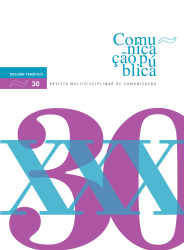Rhetoric of Pandemic Advertising
DOI:
https://doi.org/10.4000/cp.12260Keywords:
advertising, rhetoric, advertising discourse, invention, brand identity, COVID 19, media discourseAbstract
At the same time that the world was devastated by the COVID-19 epidemic and global confinement c, the advertising industry suffered a substantial shake, which poses enormous challenges.
This article investigates the adaptation of discursive strategies that the pandemic advertising discourse records and, particularly, identifies the main messages conveyed. Although it may be a space for evasion and entertainment, in the case of the COVID-19 pandemic, the analysed advertising reflects the social transformations experienced by individuals and stands as a responsible voice that fulfils the duties of social distancing and sets the examples to be followed. Thus, brands, through advertising, assume themselves as protagonists and relevant agents of responsible behaviour, thus contributing to the development of brand image.
Adopting a rhetorical point of view, the construction of messages is examined from their Invention, Arrangement, Style and Delivery. It is concluded that there is an enormous uniformity in the rhetorical construction of pandemic advertising, in which the Invention focuses on the thesis "separated but together" and unfolds in two sub-thesis: "we will overcome this together"; and "we have always been present and will always be".
Downloads
References
Chu, S.-C., & Kim, J. (2018). The current state of knowledge on electronic word-of-mouth in advertising research. International Journal of Advertising, 37(1), 1–13.
Hayes, J. L. & King, K. W. (2014). The social exchange of viral ads: Referral and coreferral of ads among college students. Journal of Interactive Advertising, 14(2), 98–109.
Mateus, S. (2019). Retórica da Publicidade. Rhetoriké- revista digital de retórica, 6. http://ojs.labcom-ifp.ubi.pt/index.php/rhetorike/issue/view/33/showToc
Mateus, S. (2019a, maio 13). A Publicidade como discurso epidíctico. Retórica Mediatizada [Conferência]. FCSH – Universidade Nova de Lisboa, Lisboa.
Porter, L., & Golan, G. J. (2006). From Subservient Chickens to Brawny Men: A Comparison of Viral Advertising to Television Advertising. Journal of Interactive Advertising, 6(2). http://jiad.org/article78.html
Taylor, C. R. (2020). Advertising and COVID-19, International Journal of Advertising, 39(5), 587-589. DOI: 10.1080/02650487.2020.1774131.
Vorhaus, M. (2020, 27 de abril). COVID-19 Represents The Biggest Challenge To Media Advertising Expenditures Ever. Forbes. https://www.forbes.com/sites/mikevorhaus/2020/04/27/covid-19-represents-the-biggest-challenge-to-media-advertising-expenditures-ever/?sh=47ea08007398
Downloads
Published
Issue
Section
License
Copyright (c) 2021 Direitos do Autor (c) 2021

This work is licensed under a Creative Commons Attribution-NonCommercial 4.0 International License.
Os conteúdos da Comunicação Pública estão licenciados com uma licença Creative Commons - Atribuição-NãoComercial 4.0 Internacional.


